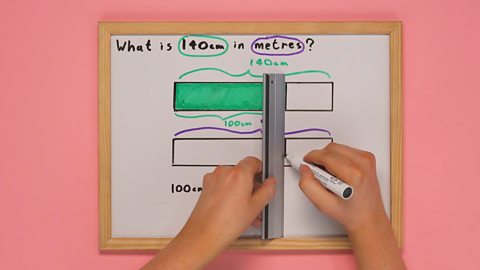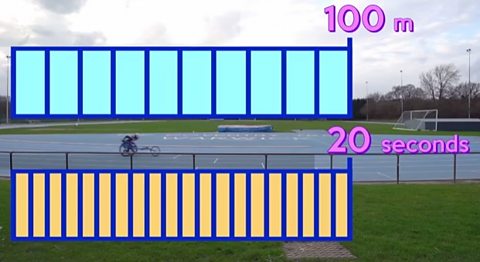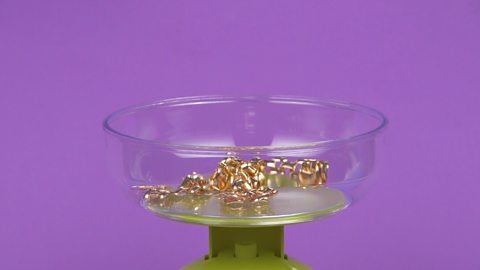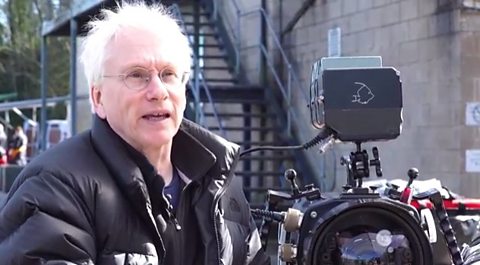Choosing appropriate units
The commonly used metric units of length include:
- kilometres (\({km}\))
- metres (\({m}\))
- centimetres (\({cm}\))
- millimetres (\({mm}\))
The commonly used metric units of mass include:
- gram (\({g}\))
- kilogram (\({kg}\))
- tonne (\({t}\))
- milligram (\({mg}\))
The commonly used metric units of capacity include:
- litre (\({l}\))
- millilitre (\({ml}\))
- cubic centimetre (\({cc}\))
Estimating
To find a suitable unit to measure something in, you should first estimate how big it is.
So, for example, do you think it's better to measure the distance between Belfast and Enniskillen in metres or kilometres, or should the length of an insect be measured in metres or millimetres?
Imagine the length of the objects you are estimating or imagine measuring them in relation to other objects.
For example:
Imagine a metre ruler next to a tall man. You would expect him to be taller than \({1}\) ruler, but not as tall as \({3}\) rulers.
Imagine a bag of sugar on some weighing scales. You would expect the needle to move round a little, but not to whizz round to \({50~kg}\).
Imagine a \({1}\)-litre bottle of cola. You would expect it to hold less than a bucket full of water.
Questions
Q1.
Which unit of measurement**(\({km}\), \({m}\), \({cm}\)or\({mm}\))**would you use for the following?
a) the length of the span of your hand
b) the length of a football pitch
c) the thickness of a notebook
d) the distance from Belfast to Enniskillen
Q2.
a) Is the height of a tall man likely to be \({90}~{cm}\), \({180}~{cm}\) or \({360}~{cm}\)?
b) Is the weight of a bag of sugar about \({1}~{kg}\), \({10}~{kg}\) or \({50}~{kg}\)?
c) Does a kettle hold roughly \({200}~{ml}\), \({1}~{l}\) or \({10}~{l}\) of liquid?
Answers
A1.
a) \({cm}\)
b) \({m}\)
c) \({mm}\)
d) \({km}\)
A2.
a) \({180}~{cm}\)
b) \({1}~{kg}\)
c) \({1}~{l}\)
Reading scales on a number line
Scale 1
In the scale above, the difference between \({5}\) and \({6}\) is \({1}\).
And, the space has been divided into \({4}\), so each division represents:
\(1 \div 4 = 0.25\)
The arrow is pointing to:
\(5 + 0.25 + 0.25 + 0.25 = 5.75\)
Scale 2
Reading scales: Scale 2
The difference between \({50}\) and \({60}\) is \({10}\) and the space has been divided into \({5}\).
So, each division represents:
\(10 \div 5 = 2\)
The arrow is pointing to:
\(50 + 2 + 2 = 54\)
Converting between units
The table shows some of the most common units and their equivalents. Make sure you know these conversions.
| Converting measurements | |||
|---|---|---|---|
| Length | \({1}~{km} = {1,000}~{m}\) | \({1}~{m} = {100}~{cm}\) | \({1}~{cm} = {10}~{mm}\) |
| Weight | \({1~tonne} = {1,000}~{kg}\) | \({1}~{kg} = {1,000}~{g}\) | \({1}~{g} = {1,000}~{mg}\) |
| Capacity | \({1}~{l} = {100}~{cl}\) | \({1}~{cl} = {10}~{ml}\) | \({1}~{l} = {1,000}~{ml}\) |
Converting larger units to smaller units
To convert a larger unit to a smaller unit (eg \({m}\) to \({cm}\)), first check the number of smaller units needed to make \({1}\) larger unit.
Then, multiply that number by the number of larger units.
Converting smaller units to larger units
To convert a smaller unit to a larger unit (eg \({cm}\) to \({m}\)), divide it by the number of smaller units which are needed to make \({1}\) larger unit.
Key point
To convert from a larger unit to a smaller one, multiply.
To convert from a smaller unit to a larger one, divide.
Example
\(1~m = 100~cm\)
So, to convert from \({m}\) to \({cm}\) multiply by \(100\), and to convert from \({cm}\) to \({m}\) divide by \(100\).
For example:
\(3.2~m = 320~cm~(3.2 \times 100 = 320)\)
\(400~cm = 4~m~(400 \div 100 = 4)\)
Question
Convert the following to the units given in brackets:
a) \(5,120~g~(kg)\)
b) \(15~cl~(ml)\)
c) \(245~mm~(m)\)
Answer
a) \(5.12~kg\)
Remember that \(1~kg = 1,000~g\).
To convert from \({g}\) to \({kg}\), divide by \(1,000\).
b) \(150~ml\)
Remember that \(1~cl = 10~ml\).
To convert from \({cl}\) to \({ml}\), multiply by \(10\).
c) \(0.245~m\)
Remember that \(1~m = 1,000~mm\).
To convert from \({mm}\) to \({m}\), divide by \(1,000\).
Converting units for area and volume
The method for converting between units works the same as the one for converting units of area and volume.
When you are converting one sort of unit to another, you need to know how many smaller units are needed to make \({1}\) larger unit.
For example: \(1~km^{2} = 1~km \times 1~km\)
\(1,000~m \times 1,000~m\)
\(1,000,000~m^{2}\)
When converting from a larger unit to a smaller unit (eg \(m^2\) to \(cm^2\)), you multiply.
When converting from a smaller unit to a larger unit (eg \(mm^2\) to \(cm^2\)), you divide.
Example 1
Convert \(50,000~cm^2\) into \(m^2\).
\(1~m = 100~cm\).
So, \(1~m^2 = 100~cm \times 100~cm = 10,000~cm^2\).
You are converting from a smaller unit \((cm^2)\) to a larger unit \((m^2)\), so divide.
\(50,000~cm^2 = 50,000 \div 10,000 = 5~m^2\).
Example 2
Example 2
Convert \(10~cm^3\) into \(mm^3\).
\(1~cm = 10~mm\).
So, \({1}~cm^{3} = {10}~mm\times{10}~mm\times{10}~mm = {1,000}~mm^{3}\).
You are converting from a larger unit \((cm^3)\) to a smaller unit \((mm^3)\), so multiply.
\({10}~cm^{3} = {10}\times{1,000} = {10,000}~mm^{3}\)
Accuracy
To check the accuracy of a rounded number, you need to find the largest and smallest numbers that it could have been rounded from.
Questions
Q1.
The number of children in a school is \(800\), correct to the nearest \(100\).
What is the largest possible and smallest possible number of children in the school?
Q2.
Amelia spends \(\pounds 80\) in the local supermarket, correct to the nearest \(\pounds 10\).
What is the greatest and least amount that Amelia could have spent?
Answers
A1.
The number of children in the school has been rounded to the nearest \(100\) to give \(800\).
The answer is \(750\) and \(849\).
The smallest number that rounds to \(800\) is \(750\).
The largest number that rounds to \(800\) is \(849\).
So, the smallest possible number of children in the school is \(750\), and the largest possible number of children is \(849\).
Note: \(850\) is exactly halfway between \(800\) and \(900\), but \(850\) rounds up to give \(900\), so we use \(849\).
A2
The answer is \(\pounds 75.00\) and \(\pounds 84.99\).
The smallest number that rounds to \(\pounds 80\) is \(\pounds 75\).
The largest number that rounds to \(\pounds 80\) is \(\pounds 84.99\).
Remember that \(\pounds 85\) is halfway between \(\pounds 80\) and \(\pounds 90\), but \(85\) rounds up to \(90\), so we must go for the smallest possible unit less than \(85\) (in this case a penny less), which is \(\pounds 84.99\).
Speed, distance and time
Speed is worked out by dividing the distance travelled by the time taken:
\(Speed = \frac{Distance}{Time}\)
The formula can also be written in this form:
\(Speed = Distance \div Time\)
Question
If you travel \(70~km\) in \(2\) hours, what is your average speed?
Answer
\(Speed = distance \div time\)
\(Speed = 70 \div 2 = 35~km/h\)
Key point
The distance is in km and the time is in h - so the units for speed are km/h.
Metres per second
Another suitable metric unit for speed is metres per second.
Using metres per second would be suitable when measuring short distances and short periods of time.
For example, an athlete might run the \({400~m}\) race in \({56}\) seconds.
What is the average speed for the \({400~m}\) race?
\(speed = distance \div time\)
\(= 400 \div 56\)
\(= 7.14~m/s\) (\({2}\) decimal places)
If you know the speed, you can work out the time or the distance by rearranging the equation:
\(speed = distance \div time\) or \(speed = \frac{distance}{time}\)
\(distance = speed \times time\)
\(time = distance \div speed\) or \(time = \frac{distance}{speed}\)
Using the triangle
The triangle below is a good way to remember the equations.
To use the triangle, cover the value required and the formula that you need will be revealed by the location of the two values that you can see.
For example:
- For time, you see distance above speed, so \(time = \frac{distance}{speed}\)
- For distance, you see speed alongside time, so \(distance = speed \times time\)
Question
If you walk for \(1\frac{1}{2}\) hours at an average speed of \({4}~miles/h\), how far will you have walked?
Answer
\(Speed = distance \div time\)
\(Distance = speed \times time\)
\(Distance = 4 \times 1.5 = 6~miles\)
How do you calculate two completely different things like the amount of water in a swimming pool and the time it takes to drain? Learn how with compound measures.
Test section
Question 1
Which unit is not a metric unit?
a) \({kg}\)
b) \({foot}\)
c) \({m}\)
Answer
A \({foot}\) is not a metric unit.
It's an Imperial unit.
Question 2
Which unit of measurement would you use to measure the length of a school hall?
a) \({metre}\)
b) \({kilometre}\)
c) \({mile}\)
Answer
The best unit to use to measure the length of a school hall would be a \({metre}\).
Question 3
What's the likely height of a classroom door?
a) \({100}~{cm}\)
b) \({150}~{cm}\)
c) \({200}~{cm}\)
Answer
A classroom door is approximately \({200}~{cm}\) or \({2}~{m}\) high.
Question 4
What's the reading on this scale?
Answer
First you need to find how many divisions are between the numbers.
There are \({5}\) divisions between the two numbers, and a difference of \({1}\) between the two numbers.
\({1}\div{5}={0.2}\).
So each division measures \({0.2}\).
The arrow is on the third division, so \({9}+{0.2}+{0.2}+{0.2}={9.6}\).
Question 5
How many \({kg}\) is \({648}~{g}\)?
Answer
Remember that \({1}~{kg}={1,000}~{g}\), so \({648}~{g}\div{1,000}={0.648}~{kg}\).
Question 6
Which unit is not a metric unit?
a) \({litre}\)
b) \({inch}\)
c) \({gram}\)
Answer
The answer is \({inch}\).
\({Litres}\) and \({grams}\) are metric units.
An \({inch}\) is called an Imperial unit.
Question 7
How many \({cm}^{3}\) are there in \({1}~{m}^{3}\)?
Answer
\({1}~{m}={100}~{cm}\), therefore \({1}~{m}^{3}={100}\times{100}\times{100}={1,000,000}~{cm}^{3}\).
Question 8
Convert \({20}~{cm}^{2}\) into \({mm}^{2}\).
Answer
\({1}~{cm}^{2}={10}~{mm}\times{10}{mm}={100}~{mm}^{2}\), so \({20}~{cm}^{2}={20}\times{100}~{mm}^{2}={2,000}~{mm}^{2}\).
Question 9
Correct to the nearest \({1,000}\), the crowd in a stadium is \({18,000}\) people.
What's the smallest possible number of people in the stadium?
Answer
The smallest possible number in the crowd is \({17,500}\).
Question 10
If you travel \({62}~{miles}\) in \({2}~{hours}\), what is your average speed?
Answer
\({Speed}={distance}\div{time}\).
Therefore, \({62~miles}\div{2~hours}={31~mph}\).
More on Shape, space and measures
Find out more by working through a topic
- count23 of 52

- count24 of 52

- count25 of 52

- count26 of 52
